牛津译林版初一英语衔接教学课件:The Simple Present Tense and The Present Continuous Tense (共27张PPT)
文档属性
| 名称 | 牛津译林版初一英语衔接教学课件:The Simple Present Tense and The Present Continuous Tense (共27张PPT) |  | |
| 格式 | zip | ||
| 文件大小 | 1.0MB | ||
| 资源类型 | 教案 | ||
| 版本资源 | 牛津译林版 | ||
| 科目 | 英语 | ||
| 更新时间 | 2016-09-17 22:40:54 | ||
图片预览

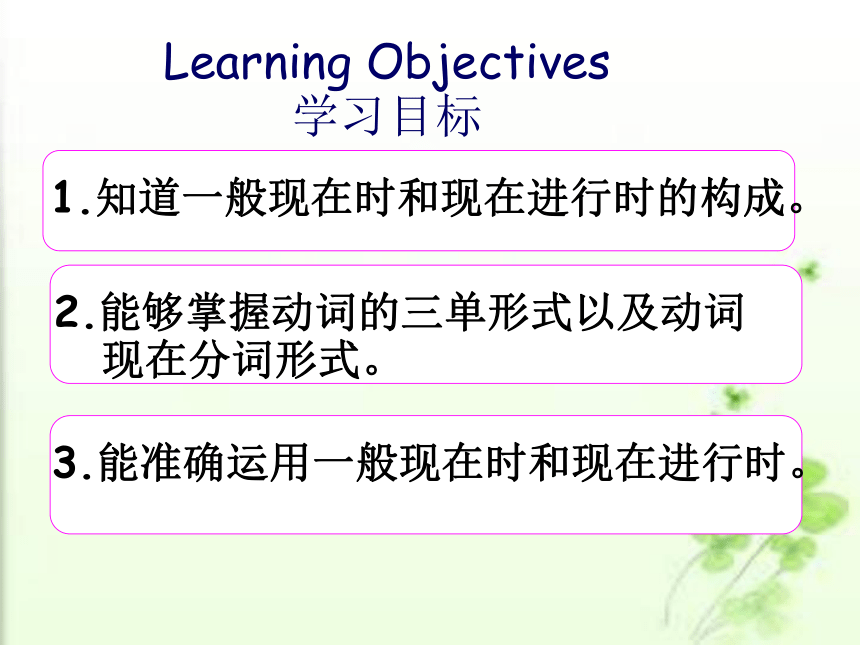
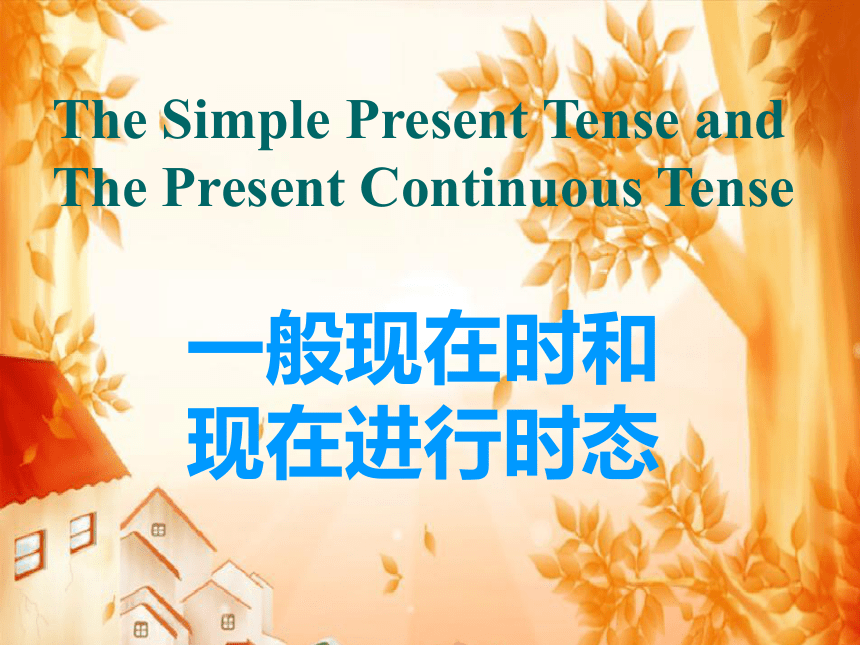
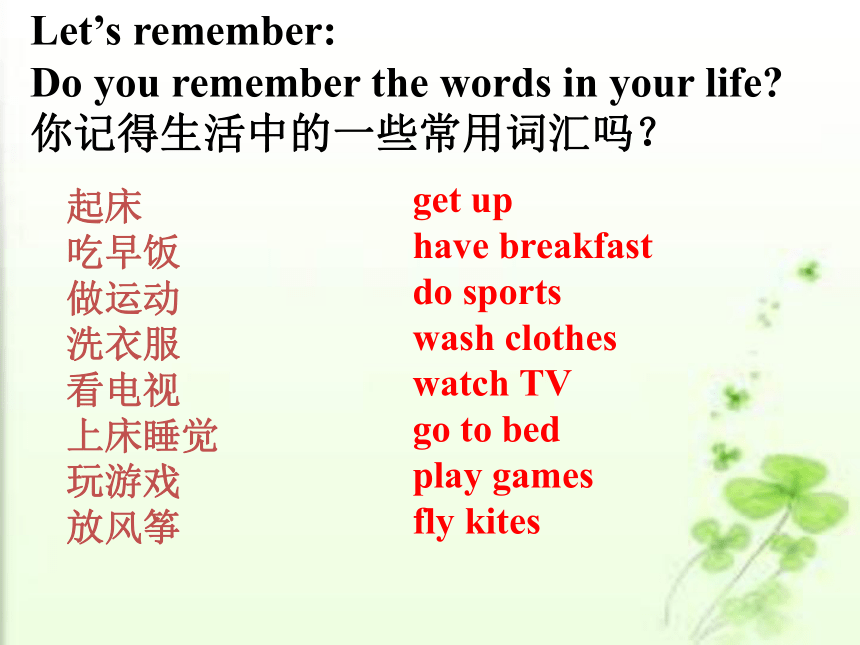
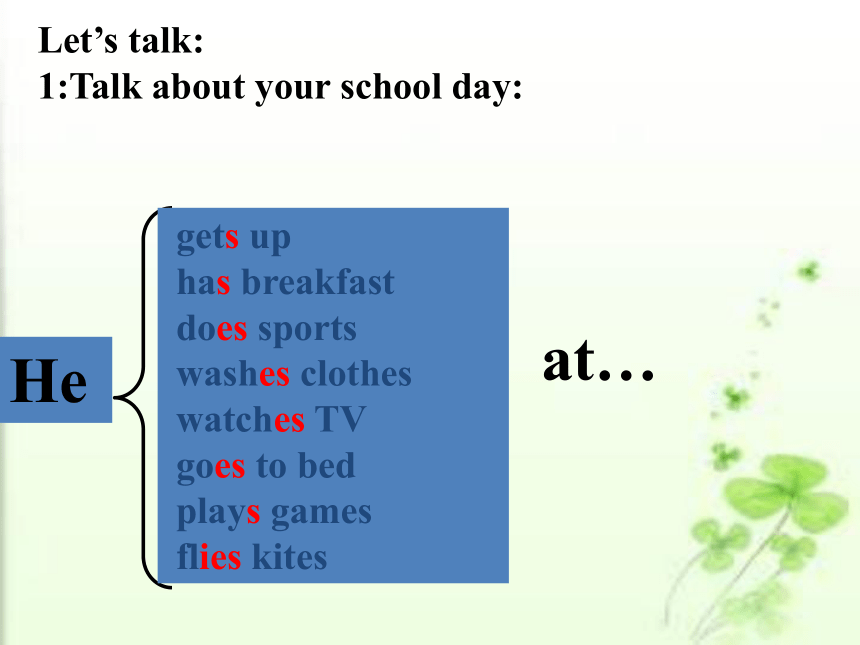
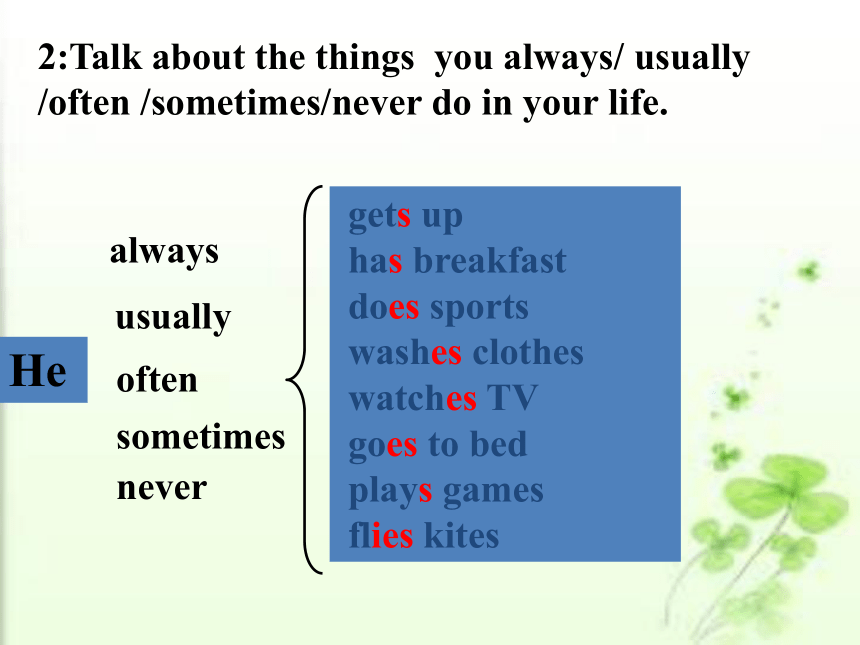
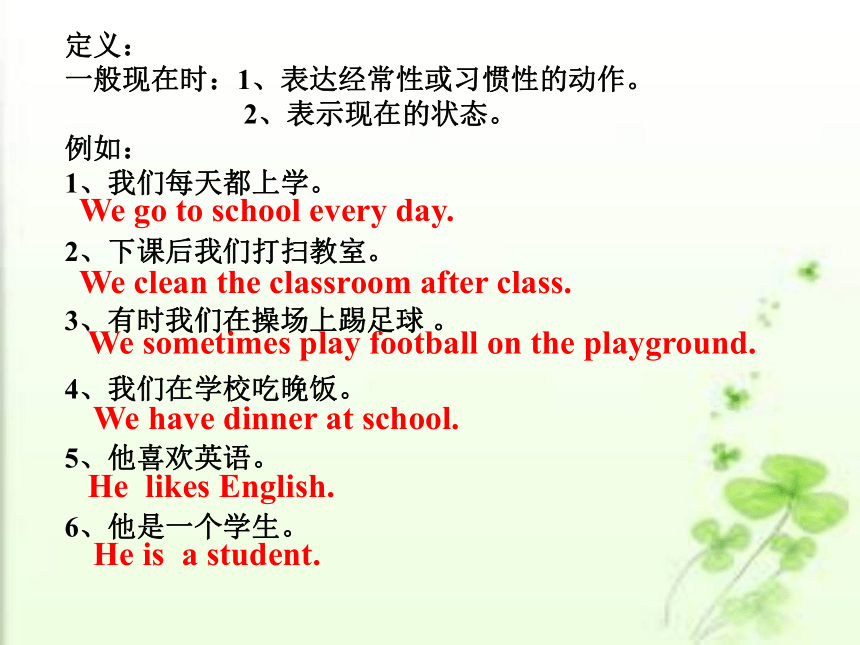
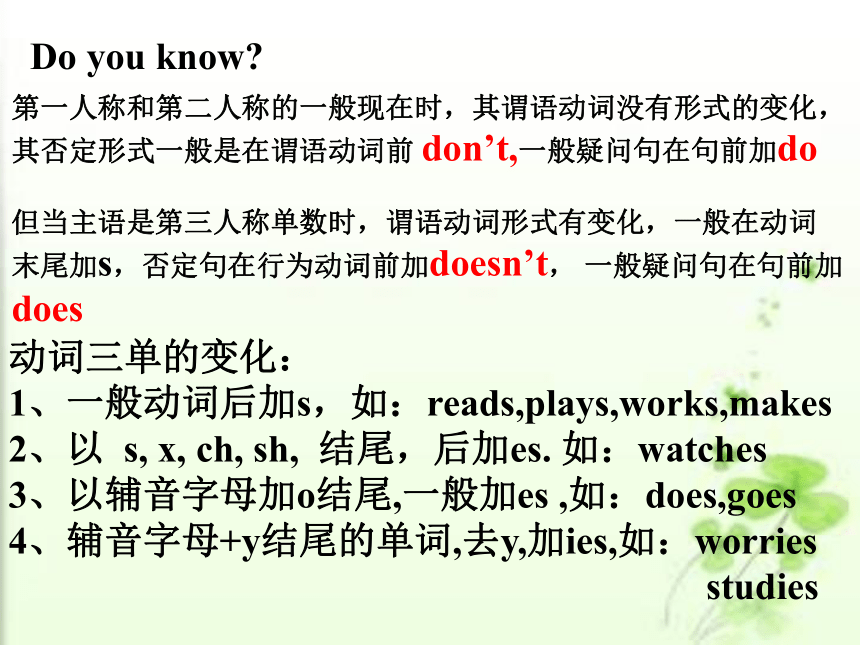

文档简介
课件27张PPT。初一英语衔接教学课件Learning Objectives
学习目标1.知道一般现在时和现在进行时的构成。2.能够掌握动词的三单形式以及动词
现在分词形式。3.能准确运用一般现在时和现在进行时。The Simple Present Tense and
The Present Continuous Tense 一般现在时和
现在进行时态Let’s remember:
Do you remember the words in your life?
你记得生活中的一些常用词汇吗?起床
吃早饭
做运动
洗衣服
看电视
上床睡觉
玩游戏
放风筝 get up
have breakfast
do sports
wash clothes
watch TV
go to bed
play games
fly kitesLet’s talk:
1:Talk about your school day:I at…He get up
have breakfast
do sports
wash clothes
watch TV
go to bed
play games
fly kites gets up
has breakfast
does sports
washes clothes
watches TV
goes to bed
plays games
flies kites2:Talk about the things you always/ usually /often /sometimes/never do in your life.
I alwaysusuallyoftensometimesneverHe get up
have breakfast
do sports
wash clothes
watch TV
go to bed
play games
fly kites gets up
has breakfast
does sports
washes clothes
watches TV
goes to bed
plays games
flies kites定义:
一般现在时:1、表达经常性或习惯性的动作。
2、表示现在的状态。
例如:
1、我们每天都上学。
2、下课后我们打扫教室。
3、有时我们在操场上踢足球 。
4、我们在学校吃晚饭。
5、他喜欢英语。
6、他是一个学生。We go to school every day.We clean the classroom after class.
We sometimes play football on the playground.We have dinner at school.He likes English.He is a student.Do you know?第一人称和第二人称的一般现在时,其谓语动词没有形式的变化,
其否定形式一般是在谓语动词前 don’t,一般疑问句在句前加do
但当主语是第三人称单数时,谓语动词形式有变化,一般在动词
末尾加s,否定句在行为动词前加doesn’t, 一般疑问句在句前加
does动词三单的变化:
1、一般动词后加s,如:reads,plays,works,makes
2、以 s, x, ch, sh, 结尾,后加es. 如:watches
3、以辅音字母加o结尾,一般加es ,如:does,goes
4、辅音字母+y结尾的单词,去y,加ies,如:worries
studiesLet’s practise:I speak English.
2.We like maths.
3.They go swimming on Sundays.
4.He gets up very early.
5.The panda eats bamboo.1.将下列句子改成否定句,一般疑问句并回答:I don’t speak English.
Do you speak English? Yes, I do/ No ,I don’t.We don’t like maths.Do you like maths? Yes, we do/ No , we don’t.They don’t go swimming on Sundays.Do they go swimming on Sundays? Yes ,they do/
No , they don’t.He doesn’t get up very early.Does he get up very early? Yes, he does/ No, he doesn’t.The panda doesn’t eat bamboo. Does the panda eat bamboo? Yes,it does/ No, it doesn’t.对下列句子画线部分提问:I get up at six o’clock.
They usually go to the park on Sunday.
The elephants like eating fruits.
He sends two emails every week.
5.I often make travel plans on the Internet.
6.He has lunch at school.
When do you get up?What do they usually do on Sunday?What do the elephants like eating?How many emails does he send every week?How often does he send two emails?What do you often do on the Internet?Who has lunch at school?Where does he have lunch?Cook, cooks, cooks dinner, cooking dinner.
Read, reads, reads a book, reading a book.
Ride, rides, rides a bike, riding a bike.
Write, writes, writes a letter, writing a letter.
Swim, swims, swims in the lake, swimming in the lake.
Run, runs, runs on the grass, running on the grass.Let’s chantTomplayfootball.isingLucy isreada book.ingLook,I reada bookamingYou runarening.now.They watchTVareingLook!The twinsthinkareing.now.What is he doing?What is she doing?He’s riding a bike.She’s walking.动词加上ing :
play----
watch----
take----
come---
run----
swim----
playingwatching1)一般加 ing .takingcoming以不发音的e 结尾, 去e,加ing
runningswimming3)以一个辅音字母加一个元音字母结尾的重读闭音节的单词,双写辅音字母+ing.说出下列动词的ing 形式.
1.help_________ 2.make_________
3.get_________ 4.eat__________
5.give________ 6.find_______
7.sit ________ 8.write________makinggettingeatinggivingfindingsittingwritinghelping现在进行时表示正在进行的动作或事情。
now, look, listen…其构成形式是
主语+ be (am/is/are) +动词ingWhat is he doing?Is the boy playing ping pong?
No, he isn’t.He is playing basketball.
Is the woman writing?No, she isn’t. She is reading a book.
What is she doing?----What’re they doing?----They’re swimming.----Are they swimming?----Yes, they are.Are they____ a book?
No, they ____.
____ are they
_______ ?
They’re _____. reading
aren’t
WhatdoingwritingIs the girl ______(get) up?
No, she ______.
What ___ she ______?
She __ ______.getting isn’tisdoingis sleepingWhat are they doing?The Simple Present Tense andThe Present Continuous TenseNothing is difficult
if you put your
heart into it. Homework:1.复习本节课所讲的语法知识。2.完成课时练习。
The Present Continuous Tense The Simple Present Tense andThank you
现在分词形式。3.能准确运用一般现在时和现在进行时。The Simple Present Tense and
The Present Continuous Tense 一般现在时和
现在进行时态Let’s remember:
Do you remember the words in your life?
你记得生活中的一些常用词汇吗?起床
吃早饭
做运动
洗衣服
看电视
上床睡觉
玩游戏
放风筝 get up
have breakfast
do sports
wash clothes
watch TV
go to bed
play games
fly kitesLet’s talk:
1:Talk about your school day:I at…He get up
have breakfast
do sports
wash clothes
watch TV
go to bed
play games
fly kites gets up
has breakfast
does sports
washes clothes
watches TV
goes to bed
plays games
flies kites2:Talk about the things you always/ usually /often /sometimes/never do in your life.
I alwaysusuallyoftensometimesneverHe get up
have breakfast
do sports
wash clothes
watch TV
go to bed
play games
fly kites gets up
has breakfast
does sports
washes clothes
watches TV
goes to bed
plays games
flies kites定义:
一般现在时:1、表达经常性或习惯性的动作。
2、表示现在的状态。
例如:
1、我们每天都上学。
2、下课后我们打扫教室。
3、有时我们在操场上踢足球 。
4、我们在学校吃晚饭。
5、他喜欢英语。
6、他是一个学生。We go to school every day.We clean the classroom after class.
We sometimes play football on the playground.We have dinner at school.He likes English.He is a student.Do you know?第一人称和第二人称的一般现在时,其谓语动词没有形式的变化,
其否定形式一般是在谓语动词前 don’t,一般疑问句在句前加do
但当主语是第三人称单数时,谓语动词形式有变化,一般在动词
末尾加s,否定句在行为动词前加doesn’t, 一般疑问句在句前加
does动词三单的变化:
1、一般动词后加s,如:reads,plays,works,makes
2、以 s, x, ch, sh, 结尾,后加es. 如:watches
3、以辅音字母加o结尾,一般加es ,如:does,goes
4、辅音字母+y结尾的单词,去y,加ies,如:worries
studiesLet’s practise:I speak English.
2.We like maths.
3.They go swimming on Sundays.
4.He gets up very early.
5.The panda eats bamboo.1.将下列句子改成否定句,一般疑问句并回答:I don’t speak English.
Do you speak English? Yes, I do/ No ,I don’t.We don’t like maths.Do you like maths? Yes, we do/ No , we don’t.They don’t go swimming on Sundays.Do they go swimming on Sundays? Yes ,they do/
No , they don’t.He doesn’t get up very early.Does he get up very early? Yes, he does/ No, he doesn’t.The panda doesn’t eat bamboo. Does the panda eat bamboo? Yes,it does/ No, it doesn’t.对下列句子画线部分提问:I get up at six o’clock.
They usually go to the park on Sunday.
The elephants like eating fruits.
He sends two emails every week.
5.I often make travel plans on the Internet.
6.He has lunch at school.
When do you get up?What do they usually do on Sunday?What do the elephants like eating?How many emails does he send every week?How often does he send two emails?What do you often do on the Internet?Who has lunch at school?Where does he have lunch?Cook, cooks, cooks dinner, cooking dinner.
Read, reads, reads a book, reading a book.
Ride, rides, rides a bike, riding a bike.
Write, writes, writes a letter, writing a letter.
Swim, swims, swims in the lake, swimming in the lake.
Run, runs, runs on the grass, running on the grass.Let’s chantTomplayfootball.isingLucy isreada book.ingLook,I reada bookamingYou runarening.now.They watchTVareingLook!The twinsthinkareing.now.What is he doing?What is she doing?He’s riding a bike.She’s walking.动词加上ing :
play----
watch----
take----
come---
run----
swim----
playingwatching1)一般加 ing .takingcoming以不发音的e 结尾, 去e,加ing
runningswimming3)以一个辅音字母加一个元音字母结尾的重读闭音节的单词,双写辅音字母+ing.说出下列动词的ing 形式.
1.help_________ 2.make_________
3.get_________ 4.eat__________
5.give________ 6.find_______
7.sit ________ 8.write________makinggettingeatinggivingfindingsittingwritinghelping现在进行时表示正在进行的动作或事情。
now, look, listen…其构成形式是
主语+ be (am/is/are) +动词ingWhat is he doing?Is the boy playing ping pong?
No, he isn’t.He is playing basketball.
Is the woman writing?No, she isn’t. She is reading a book.
What is she doing?----What’re they doing?----They’re swimming.----Are they swimming?----Yes, they are.Are they____ a book?
No, they ____.
____ are they
_______ ?
They’re _____. reading
aren’t
WhatdoingwritingIs the girl ______(get) up?
No, she ______.
What ___ she ______?
She __ ______.getting isn’tisdoingis sleepingWhat are they doing?The Simple Present Tense andThe Present Continuous TenseNothing is difficult
if you put your
heart into it. Homework:1.复习本节课所讲的语法知识。2.完成课时练习。
The Present Continuous Tense The Simple Present Tense andThank you
同课章节目录
- 预备课程
- Lesson 1 Nice to meet you !
- Lesson 2 A happy family
- Lesson 3 A nice school
- Lesson 4 You look cool !
- Lesson 5 Wonderful things
- Lesson 6 Have nice food
- Lesson 7 Enjoy our days
- Lesson 8 Let's have fun !
- Unit 1 This is me
- Unit 2 Let's play sports
- Unit 3 Welcome to our school
- Unit 4 My day
- Unit 5 Let’s celebrate
- Unit 6 Food and lifestyle
- Unit 7 Shopping
- Unit 8 Fashion
